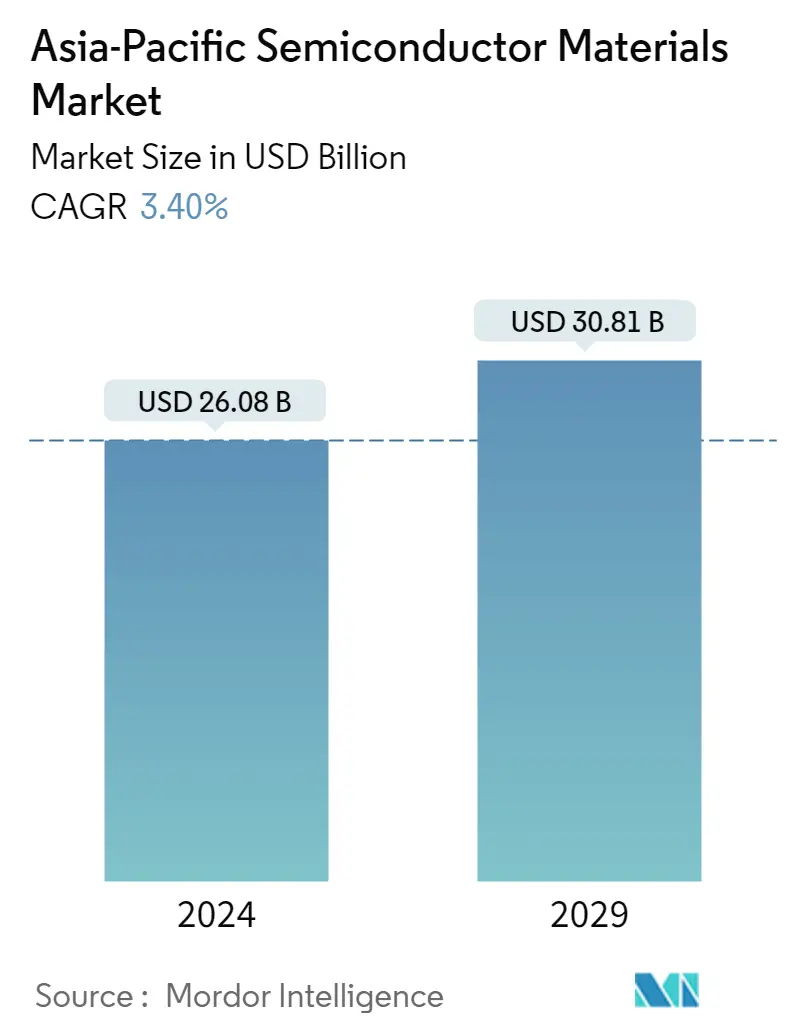Market Size of Asia-Pacific Semiconductor Materials Industry

| Study Period | 2019 - 2029 |
| Base Year For Estimation | 2023 |
| Market Size (2024) | USD 26.08 Billion |
| Market Size (2029) | USD 30.81 Billion |
| CAGR (2024 - 2029) | 3.40 % |
| Market Concentration | High |
Major Players*Disclaimer: Major Players sorted in no particular order |
Need a report that reflects how COVID-19 has impacted this market and its growth?
APAC Semiconductor Materials Market Analysis
The Asia-Pacific Semiconductor Materials Market size is estimated at USD 26.08 billion in 2024, and is expected to reach USD 30.81 billion by 2029, growing at a CAGR of 3.40% during the forecast period (2024-2029).
This may be attributed to its high electron mobility, wide temperature range, and low energy consumption. Further, the technical development of electronic devices and the rising need for semiconductor packing materials are expected to drive market growth.
- By utilizing materials such as silicon (Si), germanium (Ge), and gallium arsenide (GaAs), electronics manufacturers have been able to replace traditional thermionic devices that made electronic items heavy and non-portable. Since the inception of semiconductor elements, there has been a high degree of miniaturization, making electronic equipment more compact and mobile. Silicon is considered the best among all the semiconductor elements available in the current market scenario.
- The semiconductor industry is dominated by a few countries, mainly the U.S., Taiwan, South Korea, Japan, China, and Europe. As per SIA (U.S. Semiconductor Industry Association), 57% of the semiconductor materials, 56% of wafer fabrications, and 70% of the memory come from Asian countries. China has been investing strategically to strengthen its semiconductor industry and has been able to maintain strong supply chain control. Such factors increase the demand for semiconductor materials in the region.
- The spike in demand for consumer electronics is one of the primary reasons driving the growth of the worldwide semiconductor materials market. Furthermore, technological developments and the adoption of novel technologies such as artificial intelligence and blockchain propel the semiconductor market forward.
- According to the India Electronics and Semiconductor Association, India is anticipated to consume around USD 27 billion worth of semiconductors in 2022 and USD 70 billion by 2026. The semiconductor market will also see an increase in demand; as 5G connections are implemented and used, the performance of 5G will directly improve the production of smart products. Furthermore, Internet of Things (IoT) devices may support multiple connections simultaneously while increasing speed, latency, reliability, and battery consumption.
- The semiconductor materials market is witnessing challenges such as the costs involved in maintaining optimized levels of physical, electrical, and thermal constraints, which is difficult. Moreover, recycling smaller semiconductor materials is financially problematic, given the small amount of material reclaimed from individual products, such as smartphones.
- The COVID-19 pandemic has halted the manufacturing of several items in the semiconductor production equipment industry, owing to lockdown across the region. Lockdown measures resulted into supply chain disruption and affected catering to the demand for the consumer electronic gadgets, which had a global impact on the semiconductor sector.
